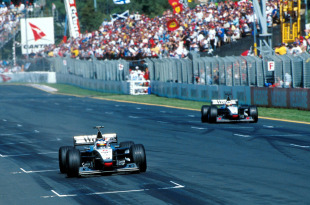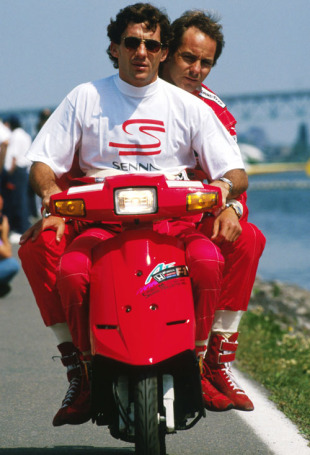- Top Ten - No. 2 Drivers
For the good of the cause

David Coulthard (to Mika Hakkinen in 98 and 99)
When David Coulthard joined Finn Mika Hakkinen at McLaren in 1996, many predicted a titanic battle between the two and a coin flip as to whom would come out on top. The first signs of trouble for Coulthard surfaced at the 1998 Australian Grand Prix when the Scot was forced to concede the lead and win after a pre-race team agreement deemed that whoever led into the first corner would take the victory. Coulthard went on to win only one race that season and spent most of the season in a supporting role as Hakkinen clinched the title. 1999 followed a similar pattern with DC winning just twice as Hakkinen secured back-to-back titles.
Eddie Irvine (to Michael Schumacher in 96-99)
"He's not only the best driver in the world, he's also the best No. 2 in the world," said Irvine of Schumacher when the German came back from a broken leg to help him win the 1999 Malaysian Grand Prix and put him firmly in the title hunt. In reality it was Irvine, not Schumacher, who was the perfect No. 2. "I did the majority of the testing, the tyre work and the chassis work. Michael could just get in the car and drive it faster than anyone else," admitted the Ulsterman, who would never again get close to winning the drivers' title.
Damon Hill (to Alain Prost in 93)
If ever there was an example of a driver making the most out of his talent, the prize must go to Damon Hill. A test-driver for Williams in 1991, Hill's big break came in securing a team-drive alongside then three-time world champion Alain Prost in 1993. Hill ably supported Prost to his fourth and final drivers' title and surprised many at the time with ten podium finishes including three wins. Three years later it was Hill who was the team leader and he went on to win the drivers' title from rookie team-mate Jacques Villeneuve.
Giancarlo Fisichella (to Fernando Alonso in 05 and 06)
When 'Fisi' stormed to victory in the 2005 Australian Grand Prix, many predicted a tough ride for the Spaniard against his new team-mate in the season ahead. Sadly, it proved a false dawn for the enigmatic Italian as a combination of poor luck and inconsistency saw Alonso storm to the title as Fisichella managed just fifth in the standings. 2006 proved to be a similar season. Having won in Malaysia he failed to maintain that pace for the forthcoming races. Some strong results in the second half of the 2006 season secured him fourth in the drivers' championship with one win and five podium finishes, a run that took valuable points off Alonso's competition as the Spaniard secured his second drivers' title in the final round of the season.
Martin Brundle (to Michael Schumacher in 92)
Of all Michael Schumacher's team-mates, the driver that was able to match him on the most regular basis was Martin Brundle. Brundle, who famously lost out in the 1983 Formula 3 title to Ayrton Senna on the final laps of the final race, outdrove the German at Imola, Montreal, Magny-Cours and Silverstone, and scored a notable second place at Monza. Brundle was also close to winning in Canada before transmission failure ended his cause when closing on leader Gerhard Berger. "The fastest guy I raced against was Mika Hakkinen. The most naturally gifted was Ayrton Senna - and in my view also the greatest. The most complete was Schumacher," confirmed Brundle.

Gerhard Berger (to Ayrton Senna in 90, 91, 92)
Gerhard Berger's arrival as Ayrton Senna's team-mate in 1990 was met with great anticipation as the experienced Austrian had proven genuinely quick during his time at Benetton and Ferrari. True to form, Berger was often quicker than predecessor Alain Prost in relation to Senna in qualifying. But he rarely matched the Brazilian's pace during races. Accordingly, Berger took only three wins in his three seasons against Senna, including a gifted 1991 Japanese Grand Prix by the newly-crowned champ. During his three years at McLaren, Berger secured four pole positions and out-qualified Senna eight times. Perhaps most notably, Berger achieved what no other of Senna's team-mates accomplished by becoming great friends with the Brazilian. Many accounts tell of practical jokes thought up by the Austrian to placate Senna's supremely focused attitude.
Ricardo Patrese (to Nigel Mansell in 91 and 92)
After two mixed seasons at Ferrari, Nigel Mansell returned to Williams in 1991 to partner Ricardo Patrese at a team expected to contend for both the drivers' and constructors' championships. Wins in Mexico and Portugal gave Patrese his most competitive ever F1 season but the Italian thus never threatened Mansell or Ayrton Senna. Williams totally dominated the 1992 season and Patrese continued to deliver in his role of second driver, even moving out of the way for Mansell while leading comfortably at that year's French Grand Prix. Patrese took only one win at the Japanese Grand Prix and had eight other podium finishes, including six second-place results, whilst Mansell recorded nine wins en-route to dominating the championship.
Rubens Barrichello (to Michael Schumacher in 2000-2005)
Unquestionably Michael Schumacher's most consistent team-mate was Rubens Barrichello. The popular Brazilian supported Schumacher to drivers' titles from 2000-2004 and helped Ferrari win the constructors' championship on no fewer than five occasions. Although he rarely threatened his team-mate, Barrichello enjoyed his most successful season in 2002, when he won four races for the team and finished a career best second place in the drivers' championship. But the year was marked by controversy when Ferrari team orders required Barrichello to let Schumacher pass him on the final straight of the 2002 Austrian Grand Prix for victory. Schumacher exchanged places with Barrichello at the podium ceremony and gave him the winner's trophy. The drivers were fined for disrupting podium protocol and Ferrari's conduct led to the FIA banning team orders in 2003.
Francois Cevert (to Jackie Stewart in 1973)
Few Formula One aficionados disagree that Sir Jackie Stewart's supremely talented young French team-mate would have gone on to be world champion had tragedy at Watkins Glen not robbed the sport of one of its future stars. Even as Cevert began to draw even with Stewart's driving abilities, the Scot was secretly planning to retire after the last race of the season in the United States and hand over the mantle of Tyrrell team leader. Leading up to the final race of the 1973 season, Cevert had finished second six times, three times behind Stewart. With Stewart having already clinched his third world championship, Cevert was killed during Saturday morning qualifying, while battling for pole position with Ronnie Peterson.
Sir Stirling Moss (to Juan Manuel Fangio in 1955)
Sir Stirling Moss is one driver who never settled for second best, but even he admits it may have been the case against the great Juan Manuel Fangio. Moss finished second to the Argentine in the 1955 championship, winning the British Grand Prix and finishing second in Belgium and Holland. Such was the aura of Fangio, Moss himself doubted whether he allowed him to win his home grand prix. He dramatically passed Fangio at the last corner to record a famous win in front of his home crowd but asked afterwards, "Did you let me win?" to which Fangio replied, "No. You were just better than me."
But if the question of pure sportsmanship was the basis of the decision, then Moss wins hands down. This noble attitude cost him the 1958 Formula One world championship. When rival Mike Hawthorn was threatened with a penalty in the Portuguese Grand Prix for reversing in the track after spinning his car, Moss defended his rival's actions. Hawthorn went on to beat Moss by a single point, even though he had only won one race that year to Moss's four. It made Hawthorn Britain's first world champion.

